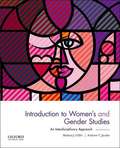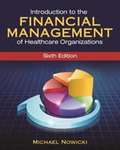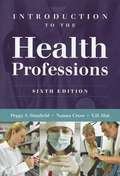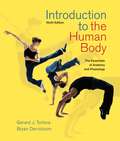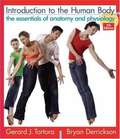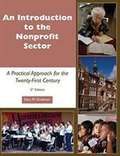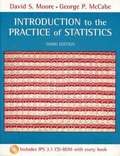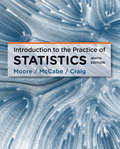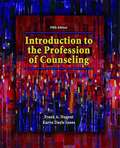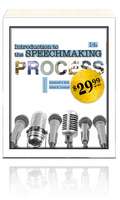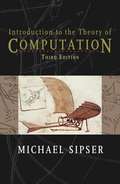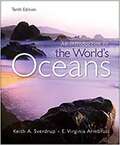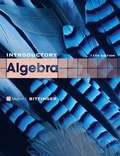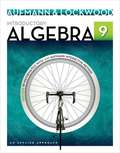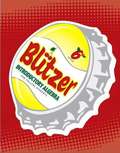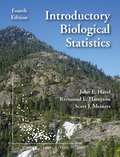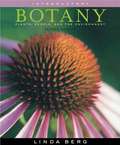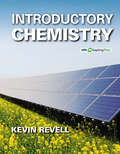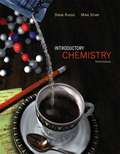- Table View
- List View
Introduction to Women's and Gender Studies: An Interdisciplinary Approach
by Melissa J. Gillis Andrew T. JacobsThis book is a truly interdisciplinary and intersectional text featuring global examples for women's, gender, and sexuality studies. Its student-centered rhetorical approach and pedagogical features―including an engaging image program, prompts for activism, a comprehensive glossary, appendices of key terms, annotated bibliographies for additional reading, and "Feminisms in Brief"―aid students in assimilating fundamental women's and gender studies terms and concepts. <P><P>While it is a textbook and not an anthology, it adopts the best facets of the anthology approach: it includes discussions of frequently anthologized writers and writing that is more engaging and narrative in style than traditional textbooks. The book systematically covers core interdisciplinary concepts so that students are prepared for women's and gender studies courses in a variety of disciplines.
Introduction to the Financial Management of Healthcare Organizations (Gateway to Healthcare Management)
by Michael NowickiNew information on capitation, entitlement reform, cost-benefit and cost-effectiveness analyses, and financial statements Recent legal action related to the distinctions between for-profit and not-for-profit hospitals Information regarding federal government actions against providers on fraud and abuse allegations
Introduction to the Health Professions (Sixth Edition)
by Nanna Cross Y. H. Hui Peggy S. StanfieldCompletely updated, Introduction to the Health Professions, Sixth Edition provides the most current, comprehensive coverage of all the major health professions. This popular text outlines more than 75 careers and touches on every major facet of the field including training requirements, job responsibilities, and salaries. This fundamental resource provides a thorough review of the U. S. healthcare delivery system, managed care, health care financing, reimbursement, insurance coverage, Medicare, Medicaid, and the impact of new technology on healthcare services. Written specifically for students who plan to become healthcare professionals, this text will give you all the information you need for a successful career! New Topics and Updates in the Sixth Edition Historical review of the health insurance industry in the United States Expanded discussion of public health care--Medicaid, Medicare, and Children's Health Insurance Program (CHIP)New section on healthcare reform due to the Patient Protection and Affordable Care Act of 2010Up-to-date coverage of individual states' implementation of healthcare reform Future-looking perspective on the evolving roles and responsibilities in health careers and the impact of future demographic and socioeconomic changes on healthcare needs Useful information on educational grants and loan repayment programs Current data for each profession from the latest Occupational Outlook (U. S. Department of Labor, 2010 - 2011)New chapter with current information on athletic trainers Instructor Resources: Transition Guide, Instructor's Manual, PowerPoint Presentations, and a Test Bank. Student Resources: Companion Website Instructors: Bundle this product with additional Jones & Bartlett introductory health professions texts and save your students up to 30% off list price. Contact your Account Specialist for more information.
Introduction to the Human Body (Ninth Edition)
by Gerard J. Tortora Bryan H. DerricksonThe 9th edition of Tortora's "Introduction to the Human Body 8e" provides basic content, focused design, and relevant connections about the essentials of anatomy and physiology. All chapters are focused on the essential structure and functions of the human body needed for a basic understanding of homeostasis. The concise narrative is paired with outstanding illustrations, many newly revised for this edition, that help keep readers fully engaged with the topic at hand. Dynamic animations of key physiological processes as well as interactive anatomy reviews are fully integrated when the content is introduced in WileyPLUS. The new edition also features fully updated Clinical Connections that provide relevance to help understand what happens when homeostasis is disrupted, and providing insights into the content and knowledge to come in their allied health curriculum. The popular feature - Focus on Wellness - is completely updated with new content and topics. A pedagogical design is reflected in both printed text and WileyPLUS and clear learning objectives along with checkpoint questions for practice and review bookend each focused section of content within a chapter.
Introduction to the Human Body: The Essentials of Anatomy and Physiology
by Bryan Derrickson Gerard J. TortoraNIMAC-sourced textbook
Introduction to the Law of Property, Estate Planning, and Insurance
by Jethro K. Lieberman Don Mayer Daniel M. Warner George J. SiedelMayer, Warner, Siedel and Lieberman's Introduction to the Law of Property, Estate Planning and Insurance is an up-to-date textbook that covers legal issues that students must understand relating to real estate (an especially important business asset), as well as estate planning and insurance. The text is organized to permit instructors to tailor the materials to their particular approach. The authors take special care to engage students by relating law to everyday events with their clear, concise and readable style. After introductory chapters covering the legal environment of business, Introduction to the Law of Property, Estate Planning and Insurance provides students with context and essential legal concepts relating to property rights and duties, estate planning, insurance, secured transactions, mortgages, and related topics. The text provides the vocabulary and legal savvy they will need when working with these concepts, which are critical to business planning and success. With Introduction to the Law of Property, Estate Planning and Insurance, the authors have created a text that not only has both case summaries and excerpted cases, but one that you can easily customize by deleting chapters, reordering the content, adding your own material, and even editing at the line level with Flat World's easy-to-use MIYO (Make It Your Own) Platform. The free online version of the text includes embedded links to law-related videos at YouTube and other online sites for easy access by students and instructors.
Introduction to the Nonprofit Sector: A Practical Approach for the Twenty-first Century
by Gary M. GrobmanThis is an introductory text on the nonprofit sector and nonprofit organizations. It provides an overview of the history, theory, and scope of the nonprofit sector. It discusses issues facing nonprofits, such as legal and regulatory issues, ethics, quality, fiscal, and liability issues. It also provides practical guidelines for writing mission and vision statements, strategic planning, hiring, firing, lobbying, communicating, using the Internet, and other functions of nonprofit organizations. Each chapter includes a synopsis at the beginning, as well as discussion questions, activities, and bibliographic references at the end. An index is included.
Introduction to the Practice of Statistics (3rd edition)
by David S. Moore George P. MccabeThis edition is an introductory text that focuses on data and on statistical reasoning. It is elementary in mathematical level, but conceptually rich in statistical ideas and serious in its aim to help students think about data and use statistical methods with understanding.
Introduction to the Practice of Statistics (Ninth Edition)
by David S. Moore George P. Mccabe Bruce A. CraigIntroduction to the Practice of Statistics (IPS) shows students how to produce and interpret data from real-world contexts—doing the same type of data gathering and analysis that working statisticians in all kinds of businesses and institutions do every day. With this phenomenally successful approach originally developed by David Moore and George McCabe, statistics is more than just a collection of techniques and formulas. Instead, students develop a systematic way of thinking about data, with a focus on problem-solving that helps them understand statistical concepts and master statistical reasoning.
Introduction to the Practice of Statistics, Seventh Edition
by David S. Moore George P. McCabe Bruce A. CraigWith its focus on data analysis, statistical reasoning, and the way statisticians actually work, Introduction to the Practice of Statistics (IPS) helped bring the power of critical thinking and practical applications to today's statistics classroom. Unlike more traditional "plug and chug" /formula driven texts, IPS de-emphasizes probability and gives students a deeper understanding of statistics.
Introduction to the Profession of Counseling
by Frank A. Nugent; Karyn Dayle JonesThis book presents a comprehensive introduction to professional counseling, a profession that helps individuals, groups, and families work through troubles arising from problems experienced in everyday life. As with previous editions, this text's philosophical and theoretical orientation to counseling is based on a phenomenological, psychosocial, life-span developmental approach. In this approach counselors help persons resolve or work through situational, developmental transitions and conflicts within a multicultural context.
Introduction to the Social Sciences
by John Jay BonstinglThis Introduction to the Social Sciences program is based upon the author's 17 years' experience as a social science classroom teacher at the middle school and high school levels.
Introduction to the Speechmaking Process (Fourteenth Edition)
by Raymond S. Ross Diana K. LeonardGood communicators are almost always knowledgeable in the critical areas of the communication process, perception, language, logical thinking, and presentation. The Speechmaking Process addresses all of these important areas and relates them eclectically to effective and responsible public speaking. The book helps students become effective critical thinkers, language users, organizers, and ethical purveyors of informative and persuasive messages.
Introduction to the Theory of Computation (Third Edition)
by Michael SipserReaders embark on the study of a fascinating and important subject: the theory of computation. It comprises the fundamental mathematical properties of computer hardware, software, and certain applications thereof. This book is intended as an upper-level undergraduate or introductory graduate text in computer science theory. It contains a mathematical treatment of the subject, designed around theorems and proofs.
Introduction to the World's Oceans
by Keith A. Sverdrup Virginia ArmbrustAn Introduction to the World's Oceans, Tenth Edition, is an introductory oceanography text intended for students without a background in mathematics, chemistry, physics, geology, or biology. It emphasizes the role of basic scientific principles in helping understand the processes that govern the ocean and the earth. <p><p> To keep the text as current as possible, the authors conduct their own research and examine other findings such as analyzing satellite data and large-scale oceanographic programs. From this vast amount of data, they select interesting, relevant, and understandable examples that illustrate contemporary principles of oceanography. <p><p> An Introduction to the World's Oceans places greater emphasis on the physical and geological aspects of the oceans than on the chemical and geochemical properties, because the latter disciplines require more specific background knowledge. An ecological approach helps integrate the biological chapters with other subjects. Students are encouraged to look at oceanography as a cohesive and united discipline rather than a collection of subjects gathered under a marine umbrella. <p><p> As with all previous editions, the authors continue to make each chapter stand as independently as possible, so that professors can assign chapters in the order that best suits their classrooms.
Introductory Algebra An Applied Approach 9th Edition
by Richard N. Aufmann Joanne S. LockwoodAs in previous editions, the focus in INTRODUCTORY ALGEBRA remains on the Aufmann Interactive Method (AIM). Students are encouraged to be active participants in the classroom and in their own studies as they work through the examples. Student engagement is crucial to success.
Introductory Algebra 9th Edition
by Margaret L. Lial John Hornsby Terry McginnisStudents who have never studied algebra--as well as those who require further review of basic algebraic concepts before taking additional courses in mathematics, business, science, nursing, or other fields--will benefit from the text's student-oriented approach.
Introductory Algebra Student Workbook, Vol. 2 (Fifth Edition)
by Scottsdale Community College Mathematics DepartmentIntroductory Algebra Student Workbook V2 is designed to lead students through Introductory Algebra
Introductory Algebra for College Students (Sixth Edition)
by Robert BlitzerThis book provides comprehensive, in-depth coverage of the topics required in a one-term course in beginning or introductory algebra.
Introductory Biological Statistics
by Scott J. Meiners Raymond E. Hampton John E. HavelCourses such as statistics, which develop quantitative analytical skills, remain important preparation for careers in the sciences and graduate school. The book supports teaching a one-semester-long course in statistics with a focus on biological examples and applications. Students need not have any prior exposure to probability and statistics, although college algebra is recommended. The book has added concept checks in all of the chapters, as well as more definition boxes and examples. A number of substantive changes has been made in this new edition. The exercises in each chapter have now been sorted into two groups: practice exercises (with solutions in appendix B) and homework exercises (solutions available only to instructors).
Introductory Botany: Plants, People, and the Environment
by Linda R. BergClear and engaging, Linda Berg's INTRODUCTORY BOTANY: PLANTS, PEOPLE, AND THE ENVIRONMENT helps you develop an appreciation of the diverse organisms we call plants, including their remarkable adaptations to the environment and their evolutionary and ecological relationships. Filled with fascinating feature boxes, intriguing chapter-opening stories, and other applied content, the text contains interesting and topical information that will pique your curiosity and help you succeed in your course. Berg shows you the many ways in which plants are fascinating in their own right, important for the existence of all life on Earth, and useful for humans in all aspects of our lives. INTRODUCTORY BOTANY: PLANTS, PEOPLE, AND THE ENVIRONMENT is beautifully and clearly illustrated and features a dynamic art program that helps you visualize even the most complex concepts.
Introductory Chemistry
by David W. BallDavid W. Ball of Cleveland State University brings his new survey of general chemistry text, Introductory Chemistry, to the market with a fresh theme that will be sure to hold student interest: "Chemistry is Everywhere." Introductory Chemistry is intended for a one-semester introductory or preparatory chemistry course.
Introductory Chemistry
by Kevin RevellBuilding a Foundation with an Integrated Learning Experience. At its core, Introductory Chemistry is the result of a unique author vision to develop a robust combination of text and digital resources that motivate and build student confidence while providing a foundation for their success. Kevin Revell knows and understands students today. His thoughtful narrative/video/interactive program works seamlessly to provide the most accessible and engaging set of resources for introductory chemistry available. The same author voice is mirrored in all print and digital content, allowing students flexibility and ensuring a fully supported learning experience--whether using a book or going completely digital! Building a Foundation for Retention and Success. Introductory Chemistry introduces students to chemistry with an exceptionally engaging writing style that not only promotes understanding but uses devices like storytelling and analogies to help students learn at a deeper level and retain concepts. Interactive activities and online tutorials offer students targeted, hands-on practice with the most difficult concepts in the course and provide a foundation for conceptual understanding and problem solving skills. Moving from comprehension to retention, students solidify their understanding of material to the point where they just "know it. " Building a Foundation. . . Your Way! Written and developed as a flexible print and digital resource, Introductory Chemistry is designed to serve as a teaching and learning tool to meet instructors and students where they are today and provide support and tools tailored to various learning and teaching styles. Introductory Chemistry comes with a full suite of traditional textbook and lecture resources to support a traditional lecture-based course, as well as resources that make the transition to a more active classroom easier for instructors interested in doing so. Instructors who already subscribe to active learning techniques will also find tools to complement their efforts. Students can choose to access the content in the learning environment that best fits their needs: the printed narrative and pedagogy, the eBook and interactive digital tools, the video lecture modules, or a combination.
Introductory Chemistry
by Steve Russo Michael E. SilverIntroductory Chemistry,Third Edition helps readers master the quantitative skills and conceptual understanding they need to gain a deep understanding of chemistry. Unlike other books on the market that emphasize rote memory of problem-solving algorithms, Introductory Chemistry takes a conceptual approach with the idea that focusing on the concepts behind chemical equations helps readers become more proficient problem solvers. What Is Chemistry?, The Numerical Side of Chemistry, The Evolution of Atomic Theory, The Modern Model of the Atom 1, Chemical Bonding and Nomenclature, The Shape of Molecules, Chemical Reactions, Stoichiometry and the Mole, The Transfer of Electrons from One Atom to Another in a Chemical Reaction Intermolecular Forces and the Phases of Matter, What If There Were No Intermolecular Forces?, The Ideal Gas Solutions, When Reactants Turn into Products, Chemical Equilibrium, Electrolytes, Acids, and Bases, Nuclear Chemistry, The Chemistry of Carbon, Synthetic and Biological Polymers. For all readers interested in introductory chemistry.
